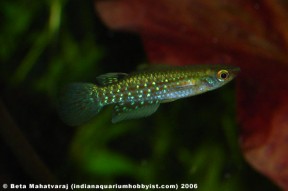Aplocheilus blockii
Green Panchax
SynonymsTop ↑
Haplochilus panchax blockii Arnold, 1911; Aplocheilus blochii Arnold, 1911
Etymology
Aplocheilus: from the Greek απλός (apló) meaning ‘simple, plain’, and χείλος (cheílos), meaning ‘lip’.
blockii:
Classification
Order: Cyprinodontiformes Family: Aplocheilidae
Distribution
Native to Sri Lanka and southern India with records in the latter existing from the states of Goa, Kerala, Tamil Nadu, and more recently, Karnataka.
Reports from Pakistan may be erroneous while the species’s distribution in certain parts of the Western Ghats mountains in India requires confirmation.
Type locality is given simply as ‘Sri Lanka’.
Habitat
This species is euryhaline and mostly inhabits lowland, often coastal, habitats containing still or slow-moving brackish or freshwater.
It displays a preference for habitats with surface vegetation or overhanging cover and is commonly found in mangrove swamps and rice paddies.
Maximum Standard Length
35 – 45 mm.
Aquarium SizeTop ↑
Minimum base dimensions of 45 ∗ 30 cm or equivalent are recommended.
Water Conditions
Temperature: 20 – 28 °C
pH: 6.0 – 8.5
Hardness: 90 – 357 ppm
Diet
Aplocheilus spp. are surface-dwelling predators preying on both aquatic and terrestrial invertebrates.
In the aquarium they will learn to accept dried foods in most cases but should also be offered regular meals of small live or frozen fare such as Artemia, Daphnia, chironomid larvae (bloodworm), etc.
Reproduction
Not difficult. This species will deposit eggs in woollen mops, fine-leaved plants or mosses, or filamentous algae depending on what is available.
Incubation is 10-15 days and the fry will initially require infusoria-grade food until large enough to accept Artemia nauplii, microworm, etc.
References
- Riehl, R. and H. A. Baensch, reprint 2004 - Mergus Verlag GmBH, Melle, Germany: 1-992
Aquarium Atlas, Volume 1. Sixth Revised English Edition.





